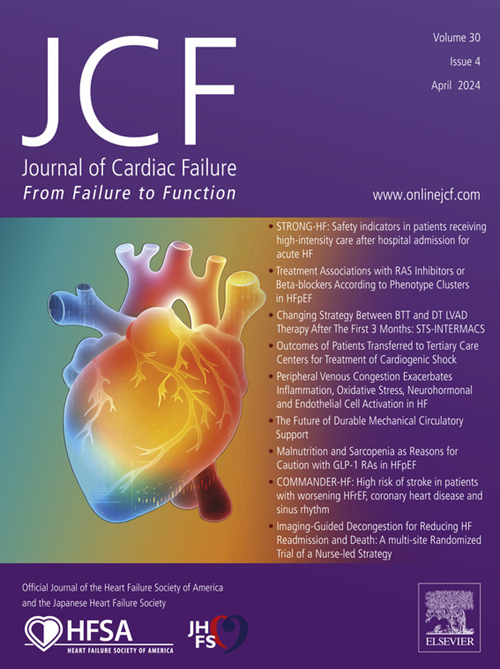Integrated Multiomics Myocardial Analysis Suggests Impaired Alternative Fuel Utilization In Heart Failure With Preserved Ejection Fraction
IF 6.7
2区 医学
Q1 CARDIAC & CARDIOVASCULAR SYSTEMS
引用次数: 0
Abstract
Introduction
Prior metabolomic data have suggested impaired metabolism of fatty acids and other fuels in heart failure with preserved ejection fraction (HFpEF). However, tissue metabolites can be lower due to lower uptake, lower flux, or higher flux/consumption. Integration of protein abundance of key metabolic enzymes can improve estimation of the overall increase or decrease in fuel utilization.
Hypothesis
Based on the prior metabolomic data, we hypothesize HFpEF will display lower protein expression of enzymes related to metabolism of fatty acids (FA) and alternative fuels.
Methods
Endomyocardial biopsies from the RV septum of HFpEF patients and RV septal tissue from non-failing controls were subjected to metabolomics (n=38 HFpEF, n=20 control), RNAseq (n=41 HFpEF, n=24 control), and protein quantification by Western blotting of key proteins related to metabolism of FA, ketones, and branched-chain amino acids (BCAA). Protein abundance was compared between HFpEF and controls using a Welch's t-test.
Results
Although expression of genes related to FA transport (ACSL1 and CPT1A) were significantly lower in HFpEF, protein abundance of CPT enzymes, known for catalyzing the formation of acylcarnitines and considered rate-limiting, were unchanged in HFpEF vs controls (Figure). In contrast, ACSL1, a pivotal mediator of FA uptake into cardiomyocytes, (P=0.002), the FATP family (P<0.05 FATP1,3,4), and enzymes of FA oxidation (ACAD [ACADM, P=0.02; ACADVL, P=0.009), HADH [HADHA, P<0.0001; HADHB, P=0.0006), and gene expression of master regulators PPARa, P<0.0001, PGC1a, P=0.01) were lower in HFpEF vs controls. Regarding ketone metabolism, protein expression of SLC16A1 (the cardiac transporter of ketones, P=0.0002), BDH1 (first enzymatic step, P=0.003), and ACAT (P=0.002) were lower in HFpEF, suggesting an overall reduction in ketone metabolism in HFpEF consistent with the metabolomic data. Regarding BCAA metabolism, BCAT2 (P=0.002) and BCKDH (P=0.0006) protein expression were lower in HFpEF vs controls, in contrast to higher BCAT gene expression in HFpEF, together suggesting impaired oxidation of both BCAA (by BCAT) and branched-chain ketoacids (by BCKDH). Phosphorylation status of BCKDH (assessed by P-BCKDH/BCKDH and BCKD kinase expression) was unchanged.
Conclusions
Integration of our findings with the prior metabolomic study suggests impaired metabolism of FA and alternative fuels (ketones and BCAA) in the myocardium in patients with HFpEF, with targeted defects associated with uptake and oxidation of both ketones and FA, and oxidation of both BCAA and branched-chain keto-acids. These findings highlight potential therapeutic targets for metabolic modulation in HFpEF.
求助全文
约1分钟内获得全文
求助全文
来源期刊

Journal of Cardiac Failure
医学-心血管系统
CiteScore
7.80
自引率
8.30%
发文量
653
审稿时长
21 days
期刊介绍:
Journal of Cardiac Failure publishes original, peer-reviewed communications of scientific excellence and review articles on clinical research, basic human studies, animal studies, and bench research with potential clinical applications to heart failure - pathogenesis, etiology, epidemiology, pathophysiological mechanisms, assessment, prevention, and treatment.
 求助内容:
求助内容: 应助结果提醒方式:
应助结果提醒方式:


